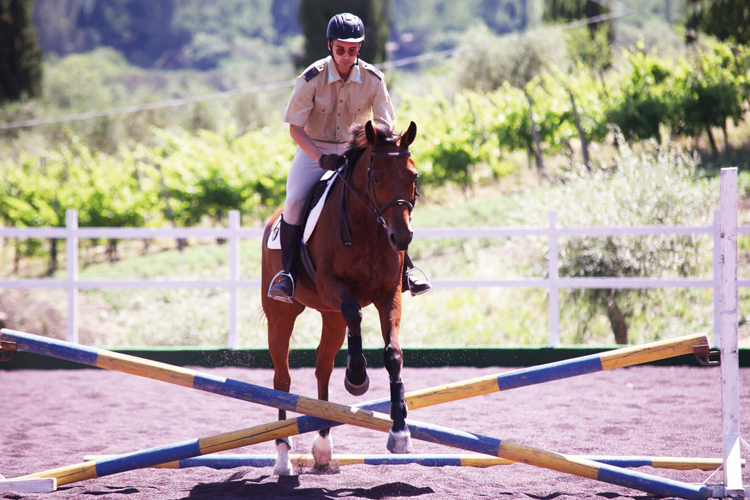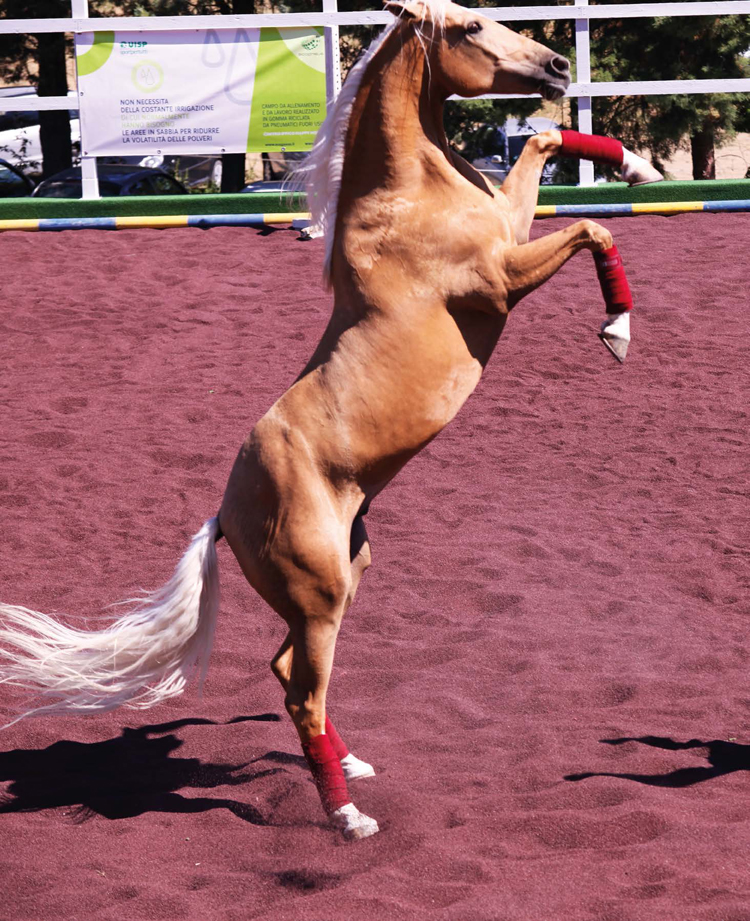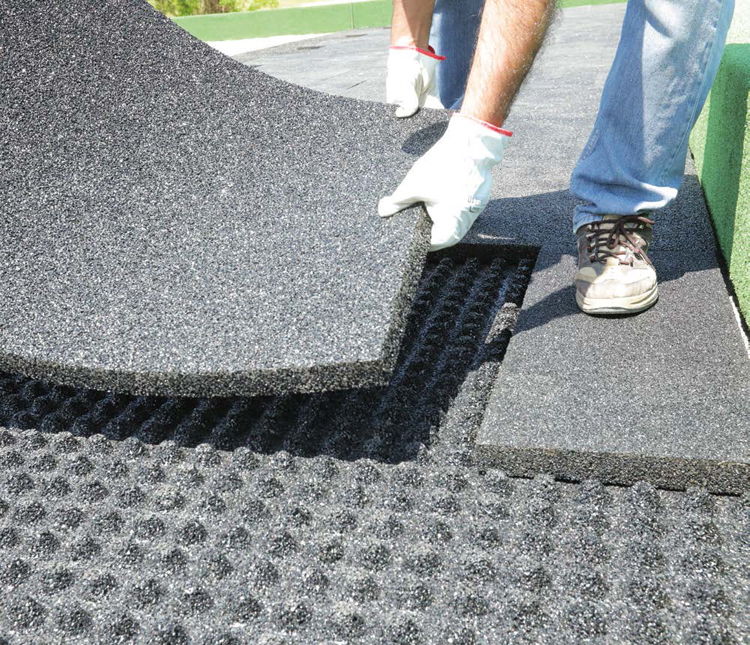From car wheels to horses’ hooves the step is shorter that you might think. To help close the gap is a project that thanks to an innovative use of recycled rubber from end-of-life tyres (ELTs) manages to merge the circular economy with animal wellbeing.
Orvieto’s Riding Centre
In Orvieto, in the green heart of Umbria, the partnership between Ecopneus – one of the main ELT managing networks in Italy – and UISP (Unione italiana sport per tutti, “Italian Sports for All Association”) has created the first riding ground entirely made with recycled rubber. An ambitious project with a double goal: reducing the onset of articular and respiratory pathologies in horses and stimulating new uses of recycled rubber in the equestrian sector. Traditional flooring normally used in these structures subjects animals’ joints to excessive stress and muscular fatigue. Moreover, the use of rubber tiles in boxes and passageways reduces the risk of dangerous slipping. But it does not stop here. With this solution, litter materials are almost eliminated, simplifying cleaning operations while improving hygiene and healthiness of premises.
An enormous advantage since workers and horses’ most common respiratory pathologies are linked to silicosis caused by the inhalation of microsilica dust rising from outdoor grounds while training. Thanks to the Ecopneus-UISP project, in the outdoor training ground of “Happy Horse” Riding Centre in Orvieto, sand has been replaced by 30,000 kg of recycled rubber granules coated with coloured polyurethane resins, in this case brown: a process that prevents excessive heating of the material, protects it from exposure to weathering and confers the product a more natural look. Under the layer of granules a bed of about 2,500 moulded rubber granules tiles was laid, taking the total of recycled rubber used in the centre to over 80,000 kg, a weight equalling about that of 9,000 car tyres. The recycled rubber was provided by two Ecopneus ELT shredding partners – Stecca in Fermo and Tritogom in Cherasco (Cuneo) – while the ground was built by Promix based in Bonate di Sotto (Bergamo).

From France to Italy
The idea of using rubber products in outdoor areas of riding centres was first introduced in Northwest France, in a riding centre in Nantes. Ecopneus and UISP decided not only to import the solution but also to adapt it to the Italian context, adding “coating” of rubber granules to make them even more suitable for their end use. Now, a team of researchers from Perugia University’s Department of Veterinary Medicine, led by Francesco Porciello, will carry out a research project in Orvieto aimed at proving the advantages already emerged from a research study carried out in Nantes. Anyway, the first impressions from experts in this field are extremely encouraging: thanks to the use of rubber granules, dust dispersal has been reduced so much that the ground no longer needs to be soaked before use; it is also clear that horses can move more comfortably thanks to rubber tiles compared to traditional hard concrete flooring.
Fabrizio Rueca, head of Respiratory Problems Studies at Perugia University, explains how the partnership with Ecopneus and UISP is moving in two directions. “The study involves environmental sampling carried out by the Occupational Health Institute through dust detectors on instructors, riders and in the environment. The veterinary side involves respiratory system endoscopy tests with bronchoalveolar lavage to spot chronic inflammation signs; silica crystals contained in sand can cause chronic respiratory illnesses and silicosis, noticed both in humans and horses.”
The first results of this research will be illustrated by Ecopneus and UISP at Fieracavalli in Verona from 26th to 29th October 2017, one the main international exhibitions dedicated to horses and riding, where about 20 boxes and passageways will be floored with prefabricated rubber tiles and where there will be a riding ground entirely paved with recycled rubber where tournaments and various activities will take place.

Searching for New Uses
Each year, Ecopneus manages about 250,000 tonnes of ELTs, amounting to the weight of 27 million car tyres: a huge amount of end-of-life products that is then destined to material and energy recovery. Despite having a calorific value greater than coal, ELTs are used to fuel power plants and cement factories, but the most interesting use – explicitly incentivized by Community legislation – is undoubtedly material recovery thanks to which tyres get a new life and are transformed into new products.
“The Orvieto project – highlights Giovanni Corbetta, Ecopneus General Manager – epitomizes our approach to the development of markets for the use of recycled rubber derived from ELTs. We started by analysing international experiments, we carried out our field scientific research studies and adapted them to the Italian market and after improving some aspects we carried them out by combining the best expertise in each sector: veterinary medicine, sports promoting bodies and businesses of the Italian circular economy. Our objective is to consolidate those uses where recycled rubber can represent a real turning point compared to other similar materials. This is the case of the equestrian sector, where the benefit is to provide a fine material that in this context can offer considerable advantages.”

Currently, the sports sector as a whole absorbs over 40% of recycled rubber from the Ecopneus network: football grounds in state-of-the-art synthetic grass, indoor and outdoor basket, volleyball, handball courts, playgrounds and riding grounds already benefit from its elastic, shock-absorbing, anti-trauma and resistance properties. Compared to energy recovery, material recovery is still the road to follow, not just for the recommendations coming from Brussels but also because recycled rubber can really make the difference compared to other similar materials from a costs, employment impact and environmental sustainability point of view.
But recycled rubber uses are not limited to the sports sector – from modified asphalt to acoustic insulation, street furniture products such as humps, speed bumps and crossing – satisfying the requirements set by the Green Public Procurement (GPP). Not surprisingly, Ecopneus has been working with the relevant ministries to define Minimum Environmental Criteria (MECs) able to encourage public administrations to opt for the green procurement of these materials; the decisive push towards the consolidation of the market of recycled rubber products also depends on this: this is the only way to get closer to the 100% material recovery threshold.
Info

